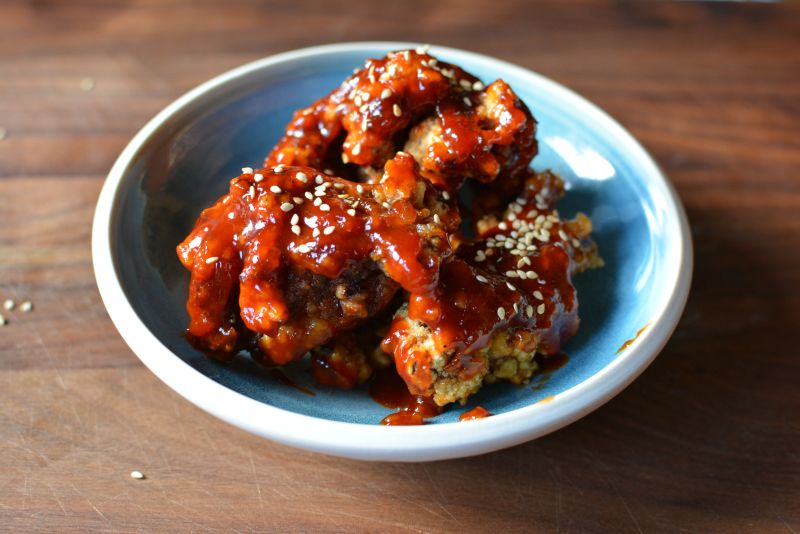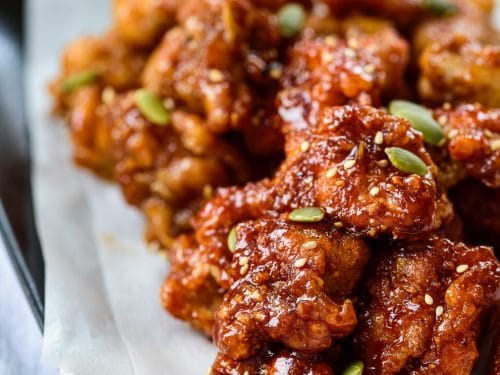Dakgangjeong, also known as Korean chicken nuggets, is a beloved Korean street food that has gained popularity worldwide for its crispy exterior and tender, flavorful interior. These bite-sized nuggets are coated in a sticky, sweet, and spicy sauce, making them irresistible to anyone who tries them. While they are commonly found in Korean restaurants and street stalls, making them at home allows you to customize the flavor and enjoy them fresh out of the fryer. In this blog post, we’ll guide you through the steps to create your own delicious batch of dakgangjeong right in your kitchen.
What is Dakgangjeong?
Dakgangjeong, often referred to as Korean chicken nuggets, is a popular Korean dish known for its crispy texture and flavorful glaze. Unlike traditional Western-style chicken nuggets, Dakgangjeong features bite-sized pieces of chicken that are coated in a sticky, sweet, and slightly spicy sauce. This dish is commonly served as a snack or appetizer but can also be enjoyed as a main course. Dakgangjeong is cherished for its addictive flavor profile, making it a favorite among both locals and visitors in Korea.
Appearance
Dakgangjeong typically consists of bite-sized pieces of chicken that are fried to golden perfection. The chicken pieces are then coated in a glossy, caramelized sauce that adds both flavor and a shiny appearance. The sauce often imparts a vibrant reddish hue, making Dakgangjeong visually appealing and enticing. Garnishes such as toasted sesame seeds and chopped green onions are often sprinkled on top to enhance both the presentation and the flavor of the dish.
Origin

Dakgangjeong has its roots in Korean cuisine and is believed to have originated in South Korea. While the exact origins of the dish are not well-documented, Dakgangjeong gained popularity as a street food in Korea before becoming a staple in Korean restaurants worldwide. The name “Dakgangjeong” can be broken down into “dak” (which means chicken) and “gangjeong” (which refers to a type of traditional Korean sweet), highlighting both the main ingredient and the sweet glaze that characterizes the dish.
Benefits
- Protein Source: Dakgangjeong provides a good source of protein from the chicken, which is essential for muscle repair and growth.
- Rich Flavor: The flavorful glaze coating the chicken adds depth and complexity to the dish, making it a satisfying and enjoyable culinary experience.
- Crispy Texture: The frying process results in a crispy exterior while maintaining tender and juicy chicken on the inside, offering a delightful contrast in texture.
- Versatility: Dakgangjeong can be customized to suit different tastes by adjusting the level of sweetness or spiciness in the sauce, making it adaptable to various preferences and dietary restrictions.
- Cultural Experience: Enjoying Dakgangjeong provides an opportunity to explore Korean cuisine and culture, allowing individuals to appreciate the unique flavors and culinary traditions of Korea.
Overall, Dakgangjeong offers not only a delicious dining experience but also a glimpse into the rich culinary heritage of Korea. Whether enjoyed as a snack, appetizer, or main course, Dakgangjeong is sure to tantalize taste buds and leave a lasting impression.
Ingredients:
- 500g boneless, skinless chicken thighs, cut into bite-sized pieces
- 1 cup potato starch or cornstarch
- Vegetable oil, for frying
- 2 tablespoons toasted sesame seeds, for garnish
- 2 tablespoons finely chopped green onions, for garnish
For the Sauce:
- 3 tablespoons soy sauce
- 2 tablespoons honey
- 1 tablespoon brown sugar
- 1 tablespoon rice vinegar
- 1 tablespoon minced garlic
- 1 tablespoon minced ginger
- 1 teaspoon Korean chili flakes (gochugaru), adjust to taste
- 1 teaspoon sesame oil
Instructions:

- Prepare the Chicken: Pat the chicken pieces dry with paper towels to remove any excess moisture. This will help the coating adhere better. Place the potato starch or cornstarch in a shallow bowl.
- Coat the Chicken: Dredge each piece of chicken in the potato starch or cornstarch, shaking off any excess. Place the coated chicken on a wire rack set over a baking sheet while you heat the oil.
- Heat the Oil: In a large skillet or wok, heat enough vegetable oil for deep frying over medium-high heat until it reaches 350°F (180°C). You can also use a deep fryer if you have one.
- Fry the Chicken: Carefully add the coated chicken pieces to the hot oil in batches, making sure not to overcrowd the pan. Fry for 5-6 minutes, or until golden brown and cooked through. Transfer the fried chicken to a paper towel-lined plate to drain excess oil.
- Make the Sauce: In a small saucepan, combine the soy sauce, honey, brown sugar, rice vinegar, minced garlic, minced ginger, Korean chili flakes, and sesame oil. Cook over medium heat, stirring constantly, until the sauce thickens slightly, about 2-3 minutes.
- Coat the Chicken with Sauce: Once all the chicken pieces are fried, transfer them to a large mixing bowl. Pour the sauce over the chicken and toss until evenly coated.
- Garnish and Serve: Transfer the saucy chicken nuggets to a serving plate and sprinkle with toasted sesame seeds and finely chopped green onions for garnish. Serve hot and enjoy!
WATCH HERE:
Frequently Asked Questions (FAQs) about Dakgangjeong
1. What does “Dakgangjeong” mean?
“Dakgangjeong” is a Korean dish consisting of bite-sized pieces of chicken that are coated in a sweet, sticky, and slightly spicy sauce. The name can be broken down into “dak” (which means chicken) and “gangjeong” (which refers to a type of traditional Korean sweet), highlighting both the main ingredient and the characteristic glaze of the dish.
2. What type of chicken is used for Dakgangjeong?
Boneless, skinless chicken thighs are commonly used for Dakgangjeong due to their tender texture and ability to retain moisture during frying. However, some recipes may use chicken breast or a combination of both.
3. Is Dakgangjeong spicy?
The level of spiciness in Dakgangjeong can vary depending on the recipe and personal preference. While some versions of the dish may have a mild spice level, others can be quite spicy. Adjusting the amount of Korean chili flakes (gochugaru) or adding chili paste (gochujang) can control the heat level.
4. Can Dakgangjeong be made ahead of time?
While Dakgangjeong is best enjoyed fresh, it can be made ahead of time and reheated if necessary. However, keep in mind that the crispy texture may diminish slightly upon reheating. To maintain crispiness, store the cooked Dakgangjeong in an airtight container in the refrigerator and reheat in an oven or air fryer.
5. Is Dakgangjeong gluten-free?
The primary ingredients used in Dakgangjeong, such as chicken and the sauce components (soy sauce, honey, etc.), are naturally gluten-free. However, it’s essential to check the labels of any store-bought ingredients, such as soy sauce, to ensure they are gluten-free if following a gluten-free diet.
6. What are some variations of Dakgangjeong?
While the classic Dakgangjeong features a sweet and spicy glaze, there are several variations of the dish. Some common variations include soy garlic Dakgangjeong, honey butter Dakgangjeong, and spicy Dakgangjeong. Each variation offers a unique flavor profile while maintaining the crispy texture of the chicken.
7. Can Dakgangjeong be made vegetarian or vegan?
Yes, Dakgangjeong can be made vegetarian or vegan by substituting the chicken with plant-based alternatives such as tofu or cauliflower. Additionally, the sauce can be adjusted to exclude animal-based ingredients by using vegan-friendly substitutes for honey and soy sauce.
8. What are some side dishes that pair well with Dakgangjeong?
Dakgangjeong pairs well with a variety of side dishes commonly found in Korean cuisine, such as steamed rice, kimchi, pickled radishes (danmuji), and Korean-style coleslaw (cabbage salad). These side dishes complement the flavors of Dakgangjeong and provide balance to the meal.
9. Can Dakgangjeong be served cold?
While Dakgangjeong is typically enjoyed hot and freshly cooked, it can also be served cold as a snack or appetizer. Cold Dakgangjeong retains its crispy texture and flavorful glaze, making it a refreshing option for warmer weather or as part of a picnic or potluck spread.
10. How long does Dakgangjeong stay crispy?
Dakgangjeong is best enjoyed immediately after frying when it is at its crispiest. However, if properly stored in an airtight container, Dakgangjeong can maintain its crispiness for several hours. To reheat Dakgangjeong and restore its crispiness, place it in a preheated oven or air fryer for a few minutes until heated through.
Making dakgangjeong at home is a rewarding experience that allows you to enjoy this delicious Korean street food anytime you crave it. With its crispy texture and sweet-spicy flavor, dakgangjeong is sure to become a favorite in your household. So, gather your ingredients and give this recipe a try for a taste of Korea right in your own kitchen!
For more recipes
